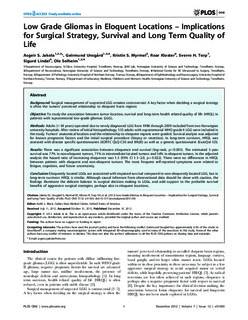| dc.contributor.author | Jakola, Asgeir S | |
| dc.contributor.author | Unsgård, Geirmund | |
| dc.contributor.author | Myrmel, Kristin Smistad | |
| dc.contributor.author | Kloster, Roar | |
| dc.contributor.author | Torp, Sverre Helge | |
| dc.contributor.author | Lindal, Sigurd | |
| dc.contributor.author | Solheim, Ole | |
| dc.date.accessioned | 2015-10-30T12:08:56Z | |
| dc.date.accessioned | 2015-11-24T12:34:50Z | |
| dc.date.available | 2015-10-30T12:08:56Z | |
| dc.date.available | 2015-11-24T12:34:50Z | |
| dc.date.issued | 2012 | |
| dc.identifier.citation | PLoS ONE 2012, 7(12) | nb_NO |
| dc.identifier.issn | 1932-6203 | |
| dc.identifier.uri | http://hdl.handle.net/11250/2365450 | |
| dc.description.abstract | Background: Surgical management of suspected LGG remains controversial. A key factor when deciding a surgical strategy
is often the tumors’ perceived relationship to eloquent brain regions
Objective: To study the association between tumor location, survival and long-term health related quality of life (HRQL) in
patients with supratentorial low-grade gliomas (LGG).
Methods: Adults ($18 years) operated due to newly diagnosed LGG from 1998 through 2009 included from two Norwegian
university hospitals. After review of initial histopathology, 153 adults with supratentorial WHO grade II LGG were included in
the study. Tumors’ anatomical location and the relationship to eloquent regions were graded. Survival analysis was adjusted
for known prognostic factors and the initial surgical procedure (biopsy or resection). In long-term survivors, HRQL was
assessed with disease specific questionnaires (EORTC QLQ-C30 and BN20) as well as a generic questionnaire (EuroQol 5D).
Results: There was a significant association between eloquence and survival (log-rank, p,0.001). The estimated 5-year
survival was 77% in non-eloquent tumors, 71% in intermediate located tumors and 54% in eloquent tumors. In the adjusted
analysis the hazard ratio of increasing eloquence was 1.5 (95% CI 1.1–2.0, p = 0.022). There were no differences in HRQL
between patients with eloquent and non-eloquent tumors. The most frequent self-reported symptoms were related to
fatigue, cognition, and future uncertainty.
Conclusion: Eloquently located LGGs are associated with impaired survival compared to non-eloquently located LGG, but in
long-term survivors HRQL is similar. Although causal inference from observational data should be done with caution, the
findings illuminate the delicate balance in surgical decision making in LGGs, and add support to the probable survival
benefits of aggressive surgical strategies, perhaps also in eloquent locations. | nb_NO |
| dc.language.iso | eng | nb_NO |
| dc.publisher | Public Library of Science | nb_NO |
| dc.title | Low Grade Gliomas in Eloquent Locations – Implications for Surgical Strategy, Survival and Long Term Quality of Life | nb_NO |
| dc.type | Journal article | nb_NO |
| dc.type | Peer reviewed | en_GB |
| dc.date.updated | 2015-10-30T12:08:56Z | |
| dc.source.volume | 7 | nb_NO |
| dc.source.journal | PLoS ONE | nb_NO |
| dc.source.issue | 12 | nb_NO |
| dc.identifier.doi | 10.1371/journal.pone.0051450 | |
| dc.identifier.cristin | 971550 | |
| dc.description.localcode | © 2012 Jakola et al. This is an open-access article distributed under the terms of the Creative Commons Attribution License, which permits unrestricted use, distribution, and reproduction in any medium, provided the original author and source are credited. | nb_NO |
